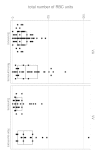Factors associated with outcomes of patients on extracorporeal membrane oxygenation support: a 5-year cohort study
- PMID: 23594433
- PMCID: PMC4056036
- DOI: 10.1186/cc12681
Factors associated with outcomes of patients on extracorporeal membrane oxygenation support: a 5-year cohort study
Abstract
Introduction: Mortality of patients on extracorporeal membrane oxygenation (ECMO) remains high. The objectives of this study were to assess the factors associated with outcome of patients undergoing ECMO in a large ECMO referral centre and to compare veno-arterial ECMO (VA ECMO) with veno-venous ECMO (VV ECMO).
Methods: We reviewed a prospectively obtained ECMO database and patients' medical records between January 2005 and June 2011. Demographic characteristics, illness severity at admission, ECMO indication, organ failure scores before ECMO and the ECMO mode and configuration were recorded. Bleeding, neurological, vascular and infectious complications that occurred on ECMO were also collected. Demographic, illness, ECMO support descriptors and complications associated with hospital mortality were analysed.
Results: ECMO was initiated 158 times in 151 patients. VA ECMO (66.5%) was twice as common as VV ECMO (33.5%) with a median duration significantly shorter than for VV ECMO (7 days (first and third quartiles: 5; 10 days) versus 10 days (first and third quartiles: 6; 16 days)). The most frequent complications during ECMO support were bleeding and bloodstream infections regardless of ECMO type. More than 70% of the ECMO episodes were successfully weaned in each ECMO group. The overall mortality was 37.3% (37.1% for the patients who underwent VA ECMO, and 37.7% for the patients who underwent VV ECMO). Haemorrhagic events, assessed by the total of red blood cell units received during ECMO, were associated with hospital mortality for both ECMO types.
Conclusions: Among neurologic, vascular, infectious and bleeding events that occurred on ECMO, bleeding was the most frequent and had a significant impact on mortality. Further studies are needed to better investigate bleeding and coagulopathy in these patients. Interventions that reduce these complications may improve outcome.
Figures


References
-
- Chen YS, Lin JW, Yu HY, Ko WJ, Jerng JS, Chang WT, Chen WJ, Huang SC, Chi NH, Wang CH, Chen LC, Tsai PR, Wang SS, Hwang JJ, Lin FY. Cardiopulmonary resuscitation with assisted extracorporeal life-support versus conventional cardiopulmonary resuscitation in adults with in-hospital cardiac arrest: an observational study and propensity analysis. Lancet. 2008;17:554–561. doi: 10.1016/S0140-6736(08)60958-7. - DOI - PubMed
-
- Australia and New Zealand Extracorporeal Membrane Oxygenation (ANZ ECMO) Influenza Investigators. Davies A, Jones D, Bailey M, Beca J, Bellomo R, Blackwell N, Forrest P, Gattas D, Granger E, Herkes R, Jackson A, McGuinness S, Nair P, Pellegrino V, Pettilä V, Plunkett B, Pye R, Torzillo P, Webb S, Wilson M, Ziegenfuss M. Extracorporeal membrane oxygenation for 2009 influenza A(H1N1) acute respiratory distress syndrome. JAMA. 2009;17:1888–1895. - PubMed
-
- Mirabel M, Luyt CE, Leprince P, Trouillet JL, Leger P, Pavie A, Chastre J, Combes A. Outcomes, long-term quality of life, and psychologic assessment of fulminant myocarditis patients rescued by mechanical circulatory support. Crit Care Med. 2011;17:1029–1035. doi: 10.1097/CCM.0b013e31820ead45. - DOI - PubMed
Publication types
MeSH terms
LinkOut - more resources
Full Text Sources
Other Literature Sources
Medical

